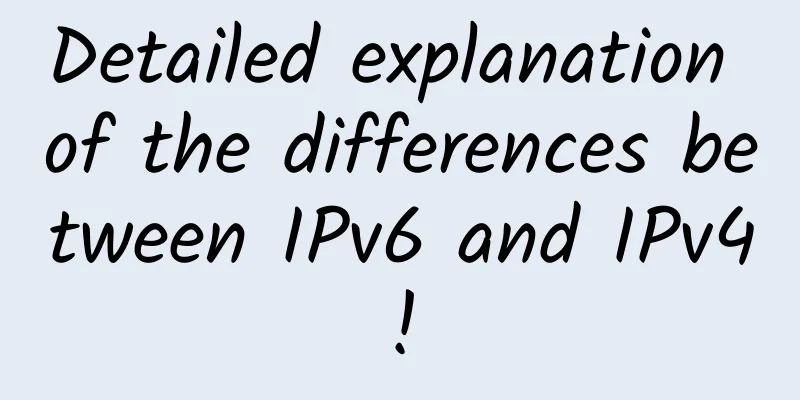Detailed explanation of the differences between IPv6 and IPv4!

|
IPv6 is the abbreviation of Internet Protocol Version 6, where Internet Protocol is translated as "Internet Protocol". IPv6 is the next-generation IP protocol designed by IETF (Internet Engineering Task Force) to replace the current version of IP protocol (IPv4), claiming that it can encode a URL for every grain of sand in the world. 1. Basic Concepts of IPV6 As we all know, IPv6 uses a 128-bit address length and has a larger address space. First, let's take a look at what IPv6 looks like. IPv6 datagrams are very different from IPv4:
Let's take a look at the IPv6 message header format: IPv6 message header The IPv6 header is simpler, with fewer fields. Compared with IPv4, there are several things to note:
The meaning here is very different from IPv4 and needs to be explained:
Why do we need to introduce the concept of extension header? This is also one of the improvements of IPv6 over IPv4. The extension header replaces the optional information of IPv4, simplifies the header of IPv6, and enhances the extensibility of IPv6. Some students may wonder how to handle IPv6 fragmented data packets? In fact, it is the use of IPv6 extension header. When sending a fragmented IPv6 datagram, IPv6 uses an extended header to organize the information of each fragment. The Next Header field value of the IPv6 message header is 44, indicating the presence of an extended header, which is the IPv6 fragment data information. Compared with IPv4, fragmentation information is recorded in the fragment field of the IPv4 message header. There are many types of IPv6 extension headers. In addition to the above-mentioned fragmentation header, there are also routing headers, hop-by-hop optional headers, etc. For details, please refer to RFC2460. This chapter mainly introduces some very intuitive understanding of IPv6. The following will gradually introduce the basic knowledge and concepts of IPv6. 2. IPv6 address syntax An IPv6 address uses colon hexadecimal notation: the 128-bit address is divided into 16-bit segments, and each 16-bit segment is represented in hexadecimal and separated by colons, for example: A common public IPv6 address:
IPv6 addresses support the representation of compressed leading zeros. For example, the address above can be compressed as follows:
To further simplify the IPv6 address, when there are several consecutive segments of 0 in the colon hexadecimal format, these segments can be compressed into a double colon representation. For example, the address above can be further simplified as follows:
For example, the IPv6 address FF80:0:0:0:FF:3BA:891:67C2 can be further simplified as follows:
It is worth noting here that the double colon can only appear once. 3. IPv6 address segmentation and prefix representation IPv6 has a huge 128-bit address space. For such a large space, it is not divided arbitrarily, but divided into number segments according to bits (similar to the zone division algorithm of some 64-bit uin transformation and release numbers within Tencent). The IPv6 address structure is as follows: For example, RFC4291 defines n=48, m=16, which means that the subnet and interface ID each occupy 64 bits. IPv6 supports a subnet prefix identification method, which is similar to the Classless Inter-Domain Routing (CIDR) mechanism of IPv4 (Note: IPv6 does not have the concept of a subnet mask). Use the "IPv6 address/prefix length" representation method, for example:
As you can see, an IPv6 address consists of a subnet prefix + interface ID. The subnet prefix is defined and allocated by the address allocation and management agency, while the interface ID can be generated by each operating system. The generation algorithm will be introduced in the following chapters. 4. IPv6 address types There are three types of IPv6 addresses:
IPv6 does not have a broadcast address, and uses a multicast address to implement the broadcast function. In fact, we are most likely to come into contact with unicast addresses in our work and life. The following article will focus on the types of unicast addresses. Students who are interested in multicast and anycast addresses can refer to the relevant RFCs and documents. |
<<: 8 Internet startups that could change the industry
>>: Is SDN the next stop for network administrators? Why is it important?
Recommend
ChatGPT and 5G messaging: the perfect combination of new artificial intelligence and new communications
At present, the hottest topic is none other than ...
All in one article: 20 industries that 5G can change
The 5G era is coming. What new changes will it br...
The content road for operators may not be smooth
Since 2018, the gap between traffic volume and re...
TCP is not that difficult, right? This is a must-read
[[242081]] Munich, 2013 Nowadays, many programmer...
5G technology has a long way to go, but power consumption and cost issues alone are enough to hinder it
5G is getting closer, but it won’t be everywhere,...
Is it OK to leave the router on for a long time? Is there any harm if I don't turn it off?
Some people say that WIFI is the vitamin of the I...
Engineers announce QUIC protocol completes RFC 9000 release
According to foreign media, the Internet Engineer...
Aruba Expands Instant On Portfolio to Support Business Continuity and Rapid Capability Expansion for SMBs
Recently, Aruba, a subsidiary of Hewlett Packard ...
The convergence of edge data centers and 5G revolutionizes data transmission and the Internet of Things
With the rapid development of the digital age, th...
Opportunity or chicken ribs? eMTC should not follow the NB-IoT price war
[[255921]] Recently, the official website of the ...
IPv6 is coming, what should we do with SDN?
IPv6 has been called for so many years, and final...
Comparison between MQTT and SSE
Building a real-time web or mobile application is...
The three-layer switch you know works like this
Why do we say that the Layer 3 forwarding perform...
Relax and have fun during the Dragon Boat Festival. WiFi signal must be strong. Here's how to adjust it
[[405404]] During the Dragon Boat Festival holida...
What is the “correct way to open” the university cloud desktop?
Colleges and universities have always been an imp...









